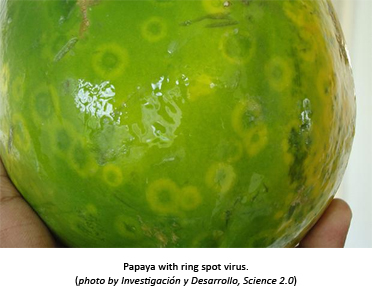As one of the leading papaya growers in the world, the prevalence of papaya ringspot virus is a constant concern. The virus leaves ring-shaped marks on the skin of the fruit, causes the flesh and skin to soften, and leaves it vulnerable to fungal growth.
More than 80% of the fruits are exported to the United States, according to the Mexican Association Industry of Plant Sanitation (AMIFAC). Europe and Asia are possible markets for 2014, requiring compliance to different phytosanitary requirements such as being free of microorganisms and having the a high-quality appearance.
To combat this problem, the Center of Research and Advanced Studies of the National Polytechnic Institute (Cinvestav) in Mexico designed a method capable of identifying the pathogen. The detection cartridge designed by Laura Silva Rosales and her team, part of the Laboratory of Virus-Plant Interactions, is made by plastic tubes filled with compounds that react to the pathogens. The leaves are deposited in the detection cartridge and the results are available within the day.
While the main pathogen is the papaya ringspot virus (PRSV), national production is also affected by the PapMV or mosaic virus, which causes leaf deformation in the form of lesions.
Rosales says that the viral problem not only affects Mexico, but all the countries where papaya is cultivated, “Some infections are not dangerous, but if temperature rises and the plant genes are susceptible to the viral strains, the plant will undergo necrosis”.
She adds that the developed cartridge is for laboratory use only, which implies that the sampling of leaves requires shipping to the lab, which is not always practical for producers. Hence Silva Rosales and her team are working in a field device that would give test results in just an hour.
“It is still in an experimental phase, and although the first tests have been effective, currently it gives results in two hours”.
With this kit, the producer would only have to macerate a leaf of the plant, place it in the cartridge, add the reactive substance and wait for the results. This, whereas negative or positive to one or both of the virus, would take a specific color depending on the case.
Although the Mexican papaya producers have experts that can identify the presence of the viruses visually, they require a scientific backup and lab test that would allow them to know which plants are infected. “The visual detection can have a margin of error up to 20%,” the researcher points out.
Source: Science 2.0

